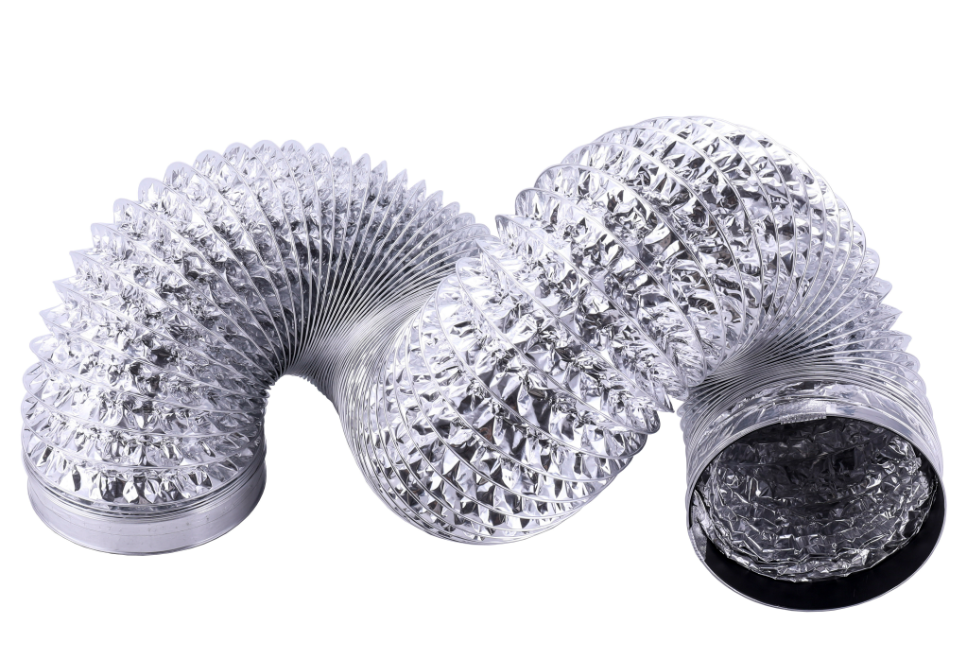Aluminum foil is a critical component in the construction of aluminum flexible ducts, widely used in heating, ventilation, and air conditioning (HVAC) systems, as well as various industrial applications. Its unique properties make it an ideal material for ensuring efficiency, durability, and performance of flexible ducts. This article delves into the application of aluminum foil in aluminum flexible ducts, highlighting its benefits and importance.
Key Properties of Aluminum Foil
1. Thermal Conductivity: Aluminum foil has excellent thermal conductivity, which allows for efficient heat transfer. This property is crucial in HVAC systems where temperature regulation is essential. Aluminum foil helps maintain the desired temperature within the ducts, whether for heating or cooling purposes.
2. Lightweight: Aluminum foil is extremely lightweight, which makes the flexible ducts easy to handle and install. This property not only simplifies the installation process but also reduces the load on structural components and supporting fixtures.
3. Corrosion Resistance: Aluminum foil forms a natural oxide layer when exposed to air, which provides strong resistance to corrosion. This characteristic ensures that the ducts have a long service life, even in environments where moisture and chemicals are present.
4. Flexibility and Malleability: Aluminum foil is highly flexible and can be easily shaped and bent without breaking. This property is particularly important in the construction of flexible ducts, which need to navigate tight spaces and sharp corners in buildings.
5. Reflectivity: Aluminum foil has a high reflectivity, which helps in insulating the ducts by reflecting heat. This feature enhances the thermal efficiency of HVAC systems by reducing heat loss or gain.

Application in Aluminum Flexible Ducts
1. Duct Construction: In the construction of aluminum flexible ducts, aluminum foil is used to form the inner and outer layers. These layers sandwich a reinforcing structure, often a helical wire, which provides strength and flexibility. The aluminum foil layers ensure that the ducts are lightweight, durable, and thermally efficient.
2. Insulation: Aluminum foil acts as an effective barrier to heat transfer. In HVAC systems, this property is exploited to maintain the desired temperature within the ducts. By reflecting radiant heat, aluminum foil helps in reducing energy consumption for heating or cooling, thus enhancing the system’s overall efficiency.
3. Moisture Barrier: The impermeable nature of aluminum foil makes it an excellent barrier against moisture. This property is particularly beneficial in preventing condensation within the ducts, which can lead to mold growth and deterioration of duct materials. Aluminum foil ensures that the air quality within the HVAC system remains high by keeping moisture at bay.
4. Sound Dampening: In addition to its thermal properties, aluminum foil also helps in sound dampening. The layers of aluminum foil in the flexible ducts can absorb and reduce the transmission of noise generated by the HVAC system, contributing to a quieter indoor environment.
5. Fire Resistance: Aluminum foil is non-combustible and can withstand high temperatures without catching fire. This fire-resistant property adds an extra layer of safety to the HVAC system, ensuring that the ducts do not contribute to the spread of fire in the event of an outbreak.

Benefits of Using Aluminum Foil in Flexible Ducts
1. Enhanced Efficiency: The thermal conductivity and reflectivity of aluminum foil improve the efficiency of HVAC systems. By minimizing heat loss and gain, aluminum foil helps in maintaining consistent temperatures, reducing the workload on heating and cooling units.
2. Durability: The corrosion-resistant nature of aluminum foil ensures that flexible ducts have a long service life. This durability reduces maintenance costs and the need for frequent replacements, providing long-term savings.
3. Ease of Installation: The lightweight and flexible nature of aluminum foil makes the ducts easy to install. This ease of installation translates to reduced labor costs and quicker setup times, making aluminum flexible ducts a cost-effective choice.
4. Safety and Air Quality: Aluminum foil’s properties as a moisture and fire barrier enhance the safety and air quality of HVAC systems. By preventing condensation and resisting fire, aluminum foil helps in maintaining a safe and healthy indoor environment.
Conclusion
Aluminum foil plays a vital role in the construction and performance of aluminum flexible ducts. Its unique properties of thermal conductivity, lightweight, corrosion resistance, flexibility, and reflectivity make it an ideal material for this application. The use of aluminum foil in flexible ducts enhances efficiency, durability, and safety, making it an indispensable component in modern HVAC systems and various industrial applications.


